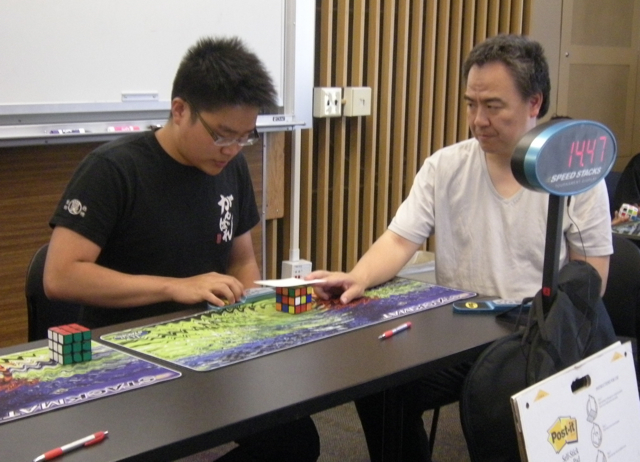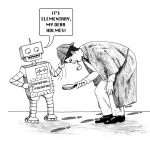George Plimpton used to play with professional sports teams. Reporters on the war in Afghanistan lived alongside the troops. Now I, too, have been an Embedded Journalist! Check out the video below (or watch it at http://youtu.be/AMwJkFSuha4).
Okay, some explanation is probably needed.
I’m currently working on Volume 9 of What’s Happening in the Mathematical Sciences, a series of books that I write for the American Mathematical Society. One of the chapters will be about recent progress on optimal solutions of the Rubik’s cube.
Recently, Tom Rokicki proved that there is no configuration of the regular 3 x 3 x 3 Rubik’s cube that requires more than 20 moves to solve. (This is known as “God’s number.”) Also, a group led by Erik Demaine found remarkably tight estimates on “God’s number” for any size of Rubik’s cube.
Independently of this theoretical progress, Rubik’s cube as a recreation has boomed in the last ten years; it is more popular now than it has been in thirty years. Since 2003 there have been regular “speedcubing” tournaments, at which competitors vie to be the fastest in various versions of Rubik’s cube-type puzzles: not only the 3 x 3 x 3 cube, but also the 4 x 4 x 4, the 5 x 5 x 5, variations like the MegaMinx and the Skewb, and also solving the regular Rubik’s cube under various handicaps (e.g., blindfolded, one-handed, or using only your feet!).
The World Cube Association‘s web page lists all of the current world records in various events (including the record for the regular cube, an amazing 5.66 seconds by Feliks Zemdegs in 2011). You can also look up the past records and see their progress over time. At the first World Championship in 2003, the fastest time for solving the cube was 16.53 seconds. The ten-second barrier was broken in 2007, by Thibaut Jacquinot of France. And now the 15-year-old Australian, Zemdegs, has taken it to the sub-six second level.
Even though the focus of my chapter is on the mathematics, not on speedcubing, I wanted to imbibe the spirit of speedcubing and take some photos to go with the article. So I went to the Stanford Spring Open 2012, also known as “Cube-a-Palooza,” which was held last weekend at Meyer Library at Stanford.
I was treated to an afternoon of nonstop action and jaw-dropping feats of legerdemain. Here are some highlights.
The winner of the competition on the “classic” 3 x 3 x 3 cube, Chai-Wei Lu (the video is also at http://youtu.be/6HdY8IMYHzs):
The winner of the one-handed competition, Jeremy Fleischman, whom you can also see coaching me in the first video above (the video is also at http://youtu.be/aylbpuZoLZU):
Sorry about the black screen at the beginning. I’m still learning this YouTube stuff… Finally, here is a video of Mitchell Lane, who didn’t win the Rubik’s Magic competition but was amazing nevertheless. The video is also at http://youtu.be/4OXxssmtJow.
So, what’s the deal with the embedded journalism? Well, at speedcubing tournaments there is a tradition of having one “mystery event” which is decided on at the competition. Sometimes it’s something as simple as seeing who can put a ball in a cup the fastest.
This time they decided to have a competition in which cubers would be paired with non-cubers. The non-cuber would be blindfolded and the cuber would have to give them directions without touching the cube. Most of the teams were kids and their parents, or in one case a boy with his sister who was a non-cuber. But I also volunteered to be a non-cubing dummy (in every sense of the word), and I was paired up with Jeremy Fleischman, who had won the one-handed competition. I’m afraid I was much more of a handicap to him! We did manage to finish second out of about six teams. (You’ll hear some applause or commotion around the 3:20 mark of the video; that was when the first team finished.)
I hope the videos give you some idea of what this fun and crazy competition is like! If you think you’d like to do it yourself, the World Cube Association page will tell you about all of the upcoming competitions (more than 300 a year).
As for photographs, I don’t want to post any that will actually appear in the book, but here is a photograph of the tournament winner that will not be in the book.




